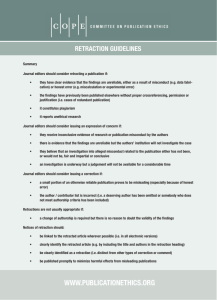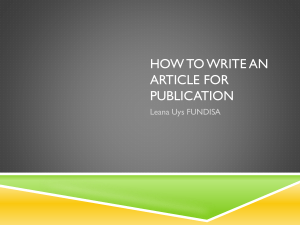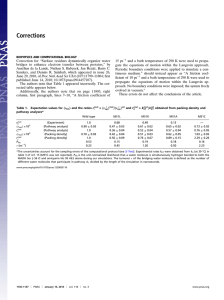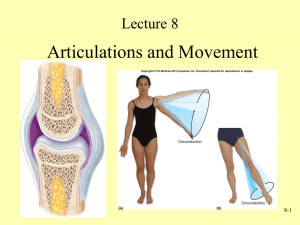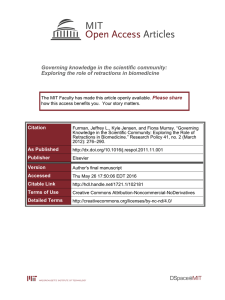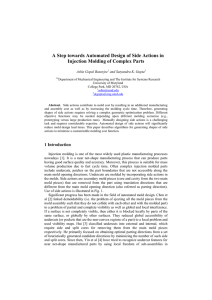Retracted Publications - Deep Blue
advertisement
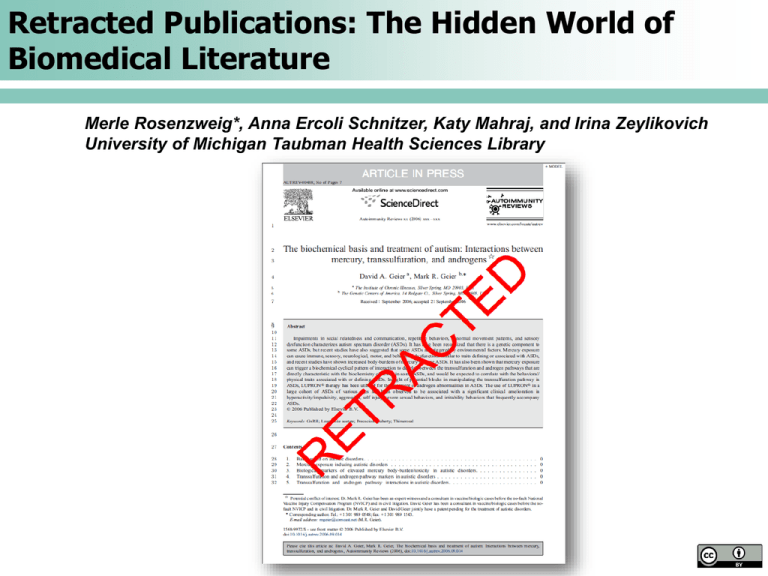
Retracted Publications: The Hidden World of Biomedical Literature Merle Rosenzweig*, Anna Ercoli Schnitzer, Katy Mahraj, and Irina Zeylikovich University of Michigan Taubman Health Sciences Library Reasons a publication may be retracted are varied • Scientific misconduct • Plagiarism or self-plagiarism • Author or copyright issues • Duplication of a publication, either by the author or the fault of the publisher • Unintentional errors • Conducting human subject research without IRB approval Surge in retracted publications Why the surge & the impact • The pressure to publish in academia to further a career. • The stigma of retraction can haunt the author or authors throughout a lengthy career, even if the reason for the retraction is not due to scientific misconduct— plagiarism, false claims or fake data—but is caused simply by embarrassing, unintentional errors. • Lead to erosion in the public mind of the trustworthiness of the results presented. • Influence the delivery of health care. Impact on Health Care of Retracted Publications • • • Mistakes in Scientific Studies Surge. Gautam Naik in The Wall Street Journal, August 10, 2011. “It was the kind of study that made doctors around the world sit up and take notice: Two popular high-blood-pressure drugs were found to be much better in combination than either alone. Two popular highblood-pressure drugs were found to be much better in combination than either alone. Unfortunately, it wasn't true.” The Lancet retraction of Andrew Wakefield’s 1998 article linking the measlesmumps-rubella (MMR) vaccine to autism. Deception at Duke: Fraud in cancer care? February 12, 2012, 60 Minutes. When Anil Potti a former Duke University medical researcher, “announced that he had an advanced, experimental treatment that would match chemotherapy to a patient's own genetic makeup, it was hailed as the holy grail of cancer care. However, when other scientists set out to verify the results, they found many problems and errors. …[the] socalled breakthrough treatment wasn't just a failure -- it may end up being one of the biggest medical research frauds ever.” Three specific aims of our research: 1. Finding the number of retractions to publications that appear in PubMed, the primary database of biomedical journals created by the National Library of Medicine. 2. Tracking the time from when a retracted article is posted on line to the time that the retraction to said article is posted. 3. Determining the reason(s) that selected articles for our study are retracted. Methods: Locating Retractions & Collecting Data PubMed: Data Points: •Publication Type: Retracted •First Author Publication •PMID •Date limit: past 10 years (from •Publication Date (month/year) 26 Nov 2011) •Retraction Date (month/year) •Results=1,292 articles Methods: Coding • • • • • Author Issues Data Error Data Manipulation Duplicate Publication IRB Approval • • • • • No Reason Given Plagiarism Self-Plagiarism Unable to Replicate Results Other Definition of Codes Results: Average of Months to Retraction Results: Average of Months to Retraction Results: Reasons for Retraction Monitoring Mechanisms • COPE (Committee on Publication Ethics) • ICMJE (International Committee of Medical Journal Editors) • Retraction Watch COPE (Committee on Publication Ethics)* “COPE aims to define best practice in the ethics of scholarly publishing and to assist editors, editorial board members, owners of journals and publishers to achieve this. One of the ways in which it fulfills this mission is by the publication of its Code of Conduct and Best Practice Guidelines for Journal Editors.” *http://publicationethics.org/ ICMJE (International Committee of Medical Journal Editors) http://www.icmje.org/ ICMJE (International Committee of Medical Journal Editors) http://www.icmje.org/publishing_2corrections.html “The retraction or expression of concern, so labeled, should appear on a numbered page in a prominent section of the print journal as well as in the online version, be listed in the Table of Contents page, and include in its heading the title of the original article. It should not simply be a letter to the editor. Ideally, the first author of the retraction should be the same as that of the article, although under certain circumstances the editor may accept retractions by other responsible persons. The text of the retraction should explain why the article is being retracted and include a complete citation reference to that article.” Retraction Watch* • A blog that reports on retractions of scientific papers. • An informal repository for retractions. • Investigate how journals themselves deal with retractions. *http://retractionwatch.wordpress.com/ Retraction Watch Emailing Alert Retraction Watch: Lance Armstrong Anti-Plagiarism Software: Free • eTBlast http://etest.vbi.vt.edu/etblast3/ • Déjà vu http://dejavu.vbi.vt.edu/dejavu/ • Developed by Virginia Bioinformatics Institute at Virginia Tech • Can detect text similarities across several databases • Can detect highly similar citations in Medline • *Users can: *Errami M, Hicks JM, Fisher W, Trusty D, Wren JD, Long TC, Garner HR. Déjà vu--a study of duplicate citations in Medline. Bioinformatics. 2008 Jan 15;24(2):243-9. iThenticate® http://www.ithenticate.com/about/ iThenticate® http://www.ithenticate.com/products/crosscheck/ CrossMark® http://www.crossref.org/crossmark/About.htm CrossMark® For Libraries http://www.crossref.org/crossmark/About.htm Questions Merle Rosenzweig oriley@umich.edu

